
Biotope Blog 2023
December 07, 2023
Successful even in energy-saving mode
Reddish-brown plumage, watchful gaze... …who is sitting so relaxed on the façade of Tower 2 at our institute? Kestrels can be spotted here more often, as a pair has already successfully bred twice on our grounds. The bird in the photo is a female – recognizable by the brown color of her head.

While the kestrel normally hunts from the air, it uses perches such as our building façades in winter to save energy and get a good overview. If it spots prey, it swoops down and finds its favorite food even under a layer of snow: small rodents.
In contrast to its northern European relative, which migrates to more southerly countries in the cold season, our native kestrel usually stays in its territory. Only when it cannot find anything to eat does it move to other areas in the region. We keep our fingers crossed that our feathered biotope resident will get its fill here!
If you would like to learn more about the kestrel, take a look at our article from June 08, 2023.
November 22, 2023
Look who showed up again
Last year, we were particularly enchanted by a little wild boar. With its striking coloration, the shoat really caught our eye. In our blog post from September 13, 2022, we already explained what the coloration was all about.
Now the animal has shown itself again. We caught it on one of our wildlife cameras in October. Now, however, not quite so small anymore.
We are delighted that this special little pig continues to roam the BioDiversum.
A very special boar
November 3, 2023
Getting safely through winter
Just as we recently changed our clocks, the animals in our BioDiversum also change their habits towards winter. Falling temperatures and a scarcer food supplies call for adjustments. Some animal species lapse into hibernation, others into winter rest or brumation. But what is the difference?

Animals in hibernation spend the cold months sleeping, usually from mid-November to March. However, this has little to do with our nightly sleep. To conserve energy, the animals’ metabolism shuts down: Body temperature, pulse, and respiration drop drastically. Fat deposits built up during the autumn help the animals to endure several months without food. Hibernators have periods of sleep lasting days to weeks, and only during short periods of wakefulness they relieve themselves or change their sleeping place. Hibernators also live in our biotope: bats and dormice.
In contrast to hibernation, the core body temperature of the animals does not drop during winter rest. Their sleep periods are much shorter, as they wake up to eat something and thus gather new energy. Examples of animals in our biotope that perform winter rest are squirrels and badgers.

Fish, frogs, lizards, turtles, and many insects have a very different strategy for getting through the winter: brumation. The cold-blooded animals cannot adapt their body temperature to their environment. Their body functions shut down almost completely, so they neither move nor eat. Some species possess their own natural ‘antifreeze agent’ in their bodies, such as alcohols, sugars, and proteins, which prevent ice crystals from forming in the body fluids. In our biotope, with snails and insects, there are many animals that engage in winter torpor.
By the way, these mechanisms also have something to do with rearranged clocks: A kind of inner clock presumably helps most animals to notice when it is time to initiate their hibernation strategy.
October 12, 2023
Nocturnal Neighbours
Photo: Soprano pipistrelle (Pipistrellus pygmaeus), © Roziline / Adobe Stock
They are small, black, and swift as an arrow: bats are rarely seen. Yet they are found almost everywhere in the world, on every continent except Antarctica. With more than 1,400 different species, the taxonomic order of the bats (Chiroptera) is the most diverse order of mammals after rodents. Our BioDiversum is also home to several bat species, as we know thanks to the regular monitorings conducted by our bat expert.
Bats play an important role in many ecosystems, as they consume vast quantities of insects, fertilize trees, disperse seeds, and pollinate flowers. In our biotope, the common pipistrelle (Pipistrellus pipistrellus) is the most common. It is the most widespread European bat species and belongs to the smallest representatives of mammals with a fighting weight of just 3.5 to 8 grams.
Other species that have been recorded gliding through the air at night on our premises in 2022 include: Nathusius’ pipistrelle (Pipistrellus nathusii), serotine bat (Eptesicus serotinus), soprano pipistrelle (Pipistrellus pygmaeus), and mouse-eared bats (Myotis spec.).
September 13, 2023
What grows in our wildflower meadows? – Part 3
European wild carrot (Daucus carota carota)
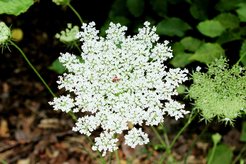
This perennial plant grows up to 120 cm high and is considered the archetype of today’s carrot. It usually appears on roadsides or embankments.
The wild carrot is very popular with insects. Wild bees, bugs, beetles, and flies of all kinds visit the flowers, while the caterpillars of the Old World swallowtail (Papilio machaon) feast on the carrot weed. The wild carrot relies on a clever trick: in the midst of the many small white partial flowers that form the umbel, there is a dark floret. It pretends to be already present clientele and thus attracts further insects.

Musk-mallow (Malva moschata)
This robust plant prefers sunny places where it blooms from July to September. It reaches a height of up to 80 cm and is widespread throughout Germany. Its flowers smell slightly of musk – hence the name. Thus, it attracts numerous insects to which it offers nectar and pollen.
Like many other mallow species, the musk-mallow is an old medicinal plant. Accordingly, it is said to be expectorant and anti-inflammatory and helps against coughs, for example.
August 28, 2023
Then & Now
In the spring of 2019, the time had come: After months of planning, the concept for our biotope was ready. All permits had been obtained and we could start implementing our measures.
Since then, our institute grounds have changed quite a bit. To what extent you can see in our before and after impressions.
The pond 2021 vs. 2023:
The meadows 2018 vs. 2023:
The areas near the buildings 2018 vs. 2023:
August 18, 2023
What grows in our wildflower meadows? – Part 2
Brown knapweed (Centaurea jacea)

This herbaceous and perennial plant reaches a height of 30 to 70 cm. It likes loamy soils and grows mainly on semi-arid grasslands, meadows, pastures, and waysides. The long flowering period into the fall makes this colorful composite a significant food source. Species that frequent it include, for example, the European common blue (Polyommatus icarus), the cabbage butterfly (Pieris rapae), the meadow brown (Maniola jurtina), the marbled white (Melanargia galathea), and the ringlet (Aphantopus hyperantus).

Ragged-robin (Lychnis flos-cuculi)
This perennial and 30-80 cm tall plant prefers a moist, humus-, and nutrient-rich loam soil directly in the sun or partial shade. It does not tolerate too many nutrients, however, nor does it tolerate prolonged drought. The ragged-robin serves as a food source for butterflies, bees, and the caterpillars of owlet moths (Noctuidae).
Its typical common name, ragged-robin, comes from the bright pink flowers with ragged petals, and the fact that both plant and bird stand out brightly at the start of summer.
August 3, 2023
The owls can come

A very special new nesting box is hanging in the BioDiversum! During his regular population surveys, our bird expert recently heard isolated tawny owl calls. To help the medium-sized owl, we decided to install a nesting aid.
Although the tawny owl (Strix aluco) is not considered endangered in Germany, it is increasingly losing nesting opportunities and habitat here. Tawny owls live mainly in deciduous and mixed forests, but can also be found in parks or other places close to settlements.
The courtship of tawny owls begins as early as December; the first eggs may be laid as early as February. Once they have moved in, the monogamous animals remain as resident birds even throughout the year in their territory. We are keeping our fingers crossed that perhaps a pair will move in this winter and that the BioDiversum will soon be enriched with new lodgers.

Note: Tawny owls hunt smaller owls, such as boreal owls (Aegolius funereus) or Eurasian pygmy owls (Glaucidium passerinum), and displace them from their territories. We only hung the nest box because our surveys did not reveal the presence of small owls on the biotope site.
July 25, 2023
What grows in our wildflower meadows? – Part 1
Viper’s bugloss (Echium vulgare)

Native to Germany, this insect magnet blooms tirelessly from May to October and reaches a growth height of up to one meter. The biennial to perennial herbaceous plant is an important food source for a variety of insects, including bees, bumblebees, and butterflies. Butterflies that feed on its nectar include for example various skippers (including Thymelicus spec.), the cabbage butterfly (Pieris brassicae), and the Old World swallowtail (Papilio machaon).
The viper’s bugloss is very adaptable, thriving even in dry and poor soils. Thus, it plays an important role for biodiversity even in ecologically challenging areas.

Bladder campion (Silene vulgaris)
The flowers of this delicate perennial plant are always open, but only at night they emit a clover-like fragrance that attracts numerous insects. Bladder campions are a valuable food source for moths and bees with long proboscises, because only they can reach the nectar deep inside its calyx. Bumblebees get around this hurdle by biting a hole in the calyx to get to the nectar.
Bladder campions grow 20 to 50 cm tall and prefer sunny locations on dry, calcareous, and lean soils.
June 27, 2023
Sleepyheads in the box
Today is “Siebenschläfer-Tag” (engl. „Dormouse Day”) in Germany and the weather for the next seven weeks is at stake. So the legend goes. But the eponymous small rodent does not care at all.
Because the day has nothing to do with the rodent European edible dormouse (Glis glis). These wild animals, which weigh just under 100 grams and belong to the dormouse family, get their German name (translated Seven-Sleepers) because they sleep an extraordinary amount of time – from September until May, i.e. for around seven months, they hibernate in underground burrows. They live in deciduous forests or large gardens from Europe to Iran.

Since the animals are nocturnal, agile, and shy, they are rarely seen. We found out by chance that they roam the BioDiversum. While collecting data for his population surveys, the bat expert discovered two dormice in our nesting boxes.
The rodents’ menu includes buds, beechnuts, acorns, hazelnuts, and fruits. To reach their desired meals, dormice are well equipped. They climb the smooth bark of trees with the help of small pointed claws and the pads of their soles, which are always slightly moist and thus act like suction cups.
Find more information about European edible dormice:
https://animalia.bio/edible-dormouse
Link to the dormouse TV of the NABU in Leverkusen:
https://nrw.nabu.de/wir-ueber-uns/infothek/webcam/index.html
June 26, 2023
Visit from Göttingen
As part of the Max Planck Day on June 23, we offered a guided tour through the BioDiversum. 15 interested visitors from Göttingen braved the rainy weather on Friday afternoon and roamed with us through the premises.
At the beginning of the tour, we gave a short outline of the development of the BioDiversum: from the original idea to the groundbreaking ceremony to the inauguration in fall 2021. Afterwards, we continued our path along colorful wildflower meadows, numerous nesting boxes, a highly frequented bird feeding station, and a growing orchard meadow, while presenting the local flora and fauna. In addition, our audience learned all about the crucial maintenance measures that are necessary to increase the biodiversity in the biotope and maintain it in the long term.
We thank the tour participants and look forward to the next visit!

June 19, 2023
The signs are up!
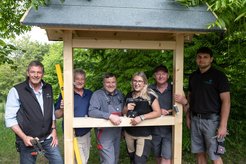
Our three new signs in the BioDiversum accompany you with a suggested round tour through the area and offer you interesting and important knowledge about our biotope mosaic. Now nothing stands in the way of a visit!
The signs were built in a team effort by colleagues and trainees from our Carpentry, Facility Management, Locksmithery, and the gardeners. The Communication & Media team was in charge of the design. Many thanks to all participants for their commitment – the result is really something to be proud of!
What do you think of our signs? Come by and see for yourselves

June 8, 2023
Hovering over the institute
Since April, they have been gliding regularly through the air, over the meadows near the pond and between the towers of the Fassberg Campus: a pair of kestrels. For the third year in a row, they have taken up residence in the kestrel box – built by our carpenter’s workshop – on tower 6 and are now busily caring for their brood. We are already eagerly waiting to see the next young kestrel generation in their box and during their first flight attempts in a few weeks.
By the way, we cannot say whether the pair of kestrels are actually the same animals as the years before. However, since kestrels are generally considered to be loyal to their location and often return to their old nesting sites, the assumption is obvious.

As synanthropic birds, kestrels follow humans into cultivated areas, such as settlements or cities, where they find more favorable living conditions. They are therefore classic city dwellers and regularly seen in Göttingen’s city center. The most distinctive feature of these birds, which are just under 35 cm tall, is their “hovering flight”. With this special flight technique, the birds remain in one place in the air in order to spot potential prey. They use their ability to perceive ultraviolet light to locate the droppings and urine of small rodents. Small mammals, such as voles and mice, are their main food source. Urban kestrels also hunt small songbirds, such as house sparrows.
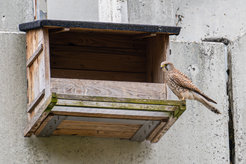
Did you know that falcons do not belong to the birds of prey? Genetic studies have shown that they are more closely related to parrots and songbirds, and have no direct relation to birds of prey. Telltale signs of this are the falcons’ narrow and pointed wings and their specially shaped beak. In addition, they do not build their own nests, but breed in niches, caves or old nests of other birds.
Link to scientific publication: Mesozoic retroposons reveal parrots as the closest living relatives of passerine birds | Nature Communications
More information about kestrels can be found here:
Kestrel Bird Facts | Falco Tinnunculus - The RSPB
UPDATE (July 20, 2023)
Unfortunately, the falcon offspring did not survive this year.
May 30, 2023
Four hotels in the BioDiversum
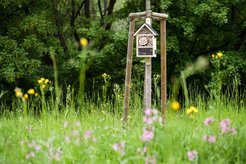

On Future Day 2023, four young craftspeople worked on a special project in our Carpentry. They were busy tinkering, hammering, and screwing with a great result: eight insect hotels. The children took one each home, and donated the remaining four to the BioDiversum.
Recently, we set up the hotels distributed all over the institute premises – always near important food sources.
To point out who built the insect shelters, each hotel is adorned with a small name plaque milled by our colleagues in the Workshop of Precision Mechanics.
Thanks to all involved in the beautiful insect hotels – we and certainly the future hotel guests are very happy!
May 10, 2023
Look who‘s swimming
We are thrilled that our pond is once again the breeding ground for hundreds (or even thousands) of common toad tadpoles this year. According to NABU (Nature And Biodiversity Conservation Union), fewer toads made their way to their spawning grounds to mate in the spring of 2023. In addition to last summer’s drought, NABU also sees traffic and increasing habitat loss as causes of the toad decline. We are all the more pleased that some toads made it to our BioDiversum.
In 2022, we have already observed swarms of tadpoles in our pond. However, these dwindled in a short time and eventually disappeared (presumably) completely. This year, we are dealing with other preconditions, though. Newts and dragonfly larvae are among the natural predators of the tadpoles – but so far we have only sighted a few specimens. Our pond planting is also increasing, providing more hiding places for the toad larvae. Altogether, the chances of some of the tadpoles growing into small toads are better this year. We will keep our eyes open with anticipation.
More information about this year's amphibian migration is available here (in German): Nachrichten zur Amphibienwanderung 2023 - NABU
Tadpoles in the BioDiversum 2023
April 26, 2023
Follow-up to our fat ball thieves

After raccoons and foxes regularly stole our bird fat balls, we tried out a new feeder. We set it up a few weeks ago and so far – despite clear bite and scratch marks – it hasn’t been plundered by uninvited guests. Let’s keep our fingers crossed that it stays that way.
March 22, 2023
Gotcha!
At first, we thought our birds in the biotope simply had a big appetite. But when not only numerous fat balls disappeared, but also their holders, our suspicion grew.
Our hunch quickly fell on the sly, cheeky thieves we had already spotted on our wildlife cameras. They are considered an invasive species in Europe: raccoons.
As part of our investigation, we set up our wildlife camera at the bird feeder in recent weeks to see what was really going on there. The result: Our suspicions have been confirmed.
Raccoons in our BioDiversum
The raccoons are not the only culprits, though. To our great surprise, someone else is helping themselves to the fat balls. Watch the video to see the other thief:
Fox in our BioDiversum
From our findings, we must now take appropriate action. First, we will no longer leave the fat balls for the birds hanging outside overnight. In the next step, we will test new holders so that we can no longer serve our cute freeloaders an all-you-can-eat buffet.
March 14, 2023
Guest at the Biodiversity Day in Nikolausberg
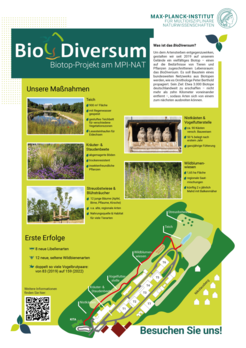
On Sunday, March 12, 2023, the local council of Nikolausberg invited to the Biodiversity Day in the community center. The aim was to exchange ideas about possible measures to counteract the decline in biodiversity in Nikolausberg. The agenda included keynote speeches and a subsequent exchange with space and time for discussion. The topics ranged from nature-friendly garden design, to the great importance of the Nikolausberg surrounding area for bird life, to the behavior of bees.
Also, the MPI-NAT was invited to present the BioDiversum. The invitation was – literally and figuratively – obvious, because our biotope borders directly on the village and is freely accessible to the public, so that many residents of Nikolausberg regularly take walks here.
In a short presentation and with the help of a poster designed for the occasion, we introduced the BioDiversum – from its beginnings to the status quo. We would like to thank the local council of Nikolausberg for the successful event and the delicious cake!
January 11, 2023
Squirrel feeding stations


Squirrels are not endangered and find sufficient food in their natural habitat. Nevertheless, we would like to support our lively little neighbors in the forest and have thus set up two feeding stations on the institute grounds. It is always nice to observe the animals there.
Our special food mix consists of hazelnuts and walnuts (with and without shell), sunflower seeds, pumpkin seeds, carob, raisins, greased oat flakes, corn kernels, banana chips and pine nuts.
It took some time before the squirrels found the first station, which had already been hanging on the grounds for several months. In the meantime, the animals are real pros and have learned how to open the lid of the food container to get to their snacks.
Station 2 has only been hanging for a few weeks and is still waiting to be discovered and ransacked.
December 20, 2022
Feeding our birds in winter
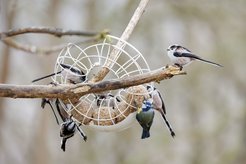
Opinions differ on the when and how to feed birds. There are good arguments for each side. We feed them all year round – as ornithologist Peter Berthold recommends. Now in the cold season as well as during breeding season, we observe the greatest rush at our bird feeder.

What do we feed?
After trying out several types of food, we found the following mixture to be an all-time favorite:
- peanuts (whole and chopped)
- sunflower seeds (with shell, peeled, and chopped)
- edible fat
- fat food
- milo
- millet
- corn grits
- oat kernels
- hemp
- mealworms
In addition, we provide energy blocks and fat balls. We always feed fat balls WITHOUT a net, since birds can receive serious injuries by tangling their legs.
How do we feed?
We offer the food mixture in a large sheltered feeder that was built by our carpentry. Such feeders are often said to be unsanitary and to promote the transmission of diseases. We therefore clean our feeder regularly to counteract such risks.
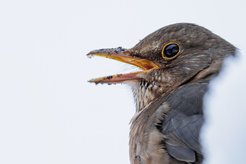
Who digs in?
In recent weeks, we have observed mainly great tits, blue tits, willow tits, marsh tits, blackbirds, crows, chaffinches, nuthatches, and great spotted woodpeckers at the feeder. Even a green or gray-headed woodpecker (it disappeared too quickly before we could clearly identify it) plundered the buffet.
To feed or not to feed?
Our guests are mostly common, non-endangered species. We hardly ever encounter rare and endangered bird species at the feeder, though. Critics of bird feeding see the danger that common species will gain a competitive advantage and that rarer species will be pushed back even further.
Proponents of bird feeding argue that the environmental conditions for our birds are bad enough, so it is important to protect each individual animal. We see it the same way.
More information
Here you can find a great informational video on the topic: The Right Way on How to Help Birds During Winter - YouTube
Our tips and tricks around bird feeding, but also around creating your own biotope can be found here:
DIY Biotope | Max Planck Institute for Multidisciplinary Sciences (mpg.de)
December 7, 2022
Ecological mowing

To ensure that the bloomage of our wildflower meadows, which we established in 2020 and 2021, lasts for a long time, they must be mowed properly – and initially twice a year. This allows short-lived species to persist longer, encourages annual flowers to self-seed, and keeps grasses from becoming too dominant.
Recently, for the first time, we had our wildflower meadows cut back with an environmentally friendly bar mower. With its low mowing speed, insects are harmed much less and can escape more easily. In addition, thanks to a clean cut, bar mowers hardly injure the individual plants.

In addition, it is also important to remove the mown material immediately. This is because plant residues that are not cleared away after mowing rot and form a nutrient-rich humus. This would make the soil undesirably “rich”. On sites that are too rich in nutrients, grasses spread and push back wildflowers.
The mowing work was carried out by an external company from the region. So far, however, there are not many companies that have ecological mowing as part of their repertoire.
November 29, 2022
Birding tours through the BioDiversum
For the second time this year, interested employees were drawn to explore the biotope. In the early morning hours, they listened with open ears to the voices, singing and chirping during a guided birding tour. Well-equipped with warm clothing, sturdy shoes and some binoculars, they encountered all kinds of birds – from hawfinches and black woodpeckers to bullfinches, chaffinches and fieldfare.
The tour guides were colleagues who, as experienced amateur ornithologists, are happy to share their knowledge with other bird enthusiasts. After both excursions, all participants were enthralled, so that regular bird tours by and for employees through the BioDiversum will also take place in the future.
If you want to learn more about the first birding tour, find here a link to an article in our institute magazine INSIDE NAT.

September 13, 2022
Biotope Cinema
Lights out, popcorn at the ready, start the movie! Our wildlife camera in the biotope has taken some exciting pictures of animal inhabitants and guests of the BioDiversum over the past months.
In our best-of video, we have compiled this year’s highlights. Badger (Meles meles), European wildcat (Felis silvestris), raccoon (Procyon lotor), and roe deer (Capreolus capreolus) gave impressive performances in front of the camera, which in our opinion are hardly inferior to a cinema blockbuster.
Best of Biotop 2022
Nevertheless, a family of wild boars (Sus scrofa) stole the show from all the other performers with a single brief appearance.
Wild boar family in the BioDiversum
Seven boarlets trot along in single file after their mother, the wild sow. One of the piggies, however, stands out in its appearance: Instead of having light brown fur with yellowish longitudinal stripes – the typicyl coloration of boarlets – it has a light skin and dark spots. Presumably, the pedigree of the sow also includes one or the other domestic pig, whose genes have had an effect on the coloring of the offspring. The little pig should not suffer any disadvantages, though, except for poorer camouflage in the forest.
Since our wildlife film does not follow a script, we are curious to see which forest dwellers will run in front of our lens next. There will certainly be a sequel to our biotope cinema!
August 25, 2022
The little oasis

Surrounded by streets, parked cars, and buildings, our central area at the front of the institute’s premises seems like an oasis. As part of our biotope project, we have fundamentally restructured and ecologically upgraded the small area. We removed shrubs that were not suited to the location, removed gravel areas, and impoverished soil by mixing in sand. Today, our employees and visitors find flowering and fruit-bearing shrubs, herbs, and trees there.
The lower area is strongly exposed to the sun. This is why we have introduced particularly drought-resistant plants, like agastache or oregano, to the delight of many bumblebees and butterflies.
We created a path through the small oasis, which makes the area tangible for the staff. It also allows a short detour into the greenery on the way from the office to the canteen.


August 17, 2022
Master Hare dropped by
A few weeks ago, a visitor jumped in front of the camera that we had not encountered before in our biotope: a European hare (Lepus europaeus). The species is widespread throughout Europe and prefers to live in semi-open areas such as farmlands and meadows, alternating with shrub-rich areas.
As pure vegetarians, they feed on a varied diet of herbs, grasses, cereals, crops, buds, shoots, and bark.
We are happy about the new guest and continue to keep our eyes and ears open for new subtenants and transients.

July 29, 2022
Fauna monitoring in the BioDiversum – First preliminary results

On the basis of regular population surveys, we want to check whether our measures are successful. In 2019, experts determined the status quo of the vegetation and various animal species, including butterflies, wild bees, birds, and bats. As planned, the experts are out again this year. The first numbers are promising:
Eight dragonfly species are now buzzing around our pond and several new butterfly species are fluttering around our wildflower meadows, including the European skipper (Thymelicus lineola), Old World swallowtail (Papilio machaon), and High Brown Fritillary (Argynnis adippe).
Well over 80 species of wild bees have been discovered at the biotope site so far, including twelve predominantly rare species, such as the Hawksbeard Mining Bee (Andrena fulvago), which is still listed as “lost” in Lower Saxony.
Among birds, almost twice as many breeding pairs compared to 2019 were recorded so far. Their number rose from 83 to 159. There was a doubling of the most common species, Eurasian blackcap (Sylvia atricapilla) and blackbird (Turdus merula), as well as significant increases in the cavity nesters great tits (Parus major), blue tits (Parus caeruleus), and nuthatches (Sitta europaea). The red-backed shrike (Lanius collurio) is a new visitor, but has not yet decided to stay.
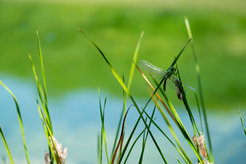

July 25, 2022
The BioDiversum in the media
In January, we got visited by a journalist who did research for an episode of the German SWR2 Wissen – Podcast.
The topic: The animal and us – the mammoth task of species protection.
Have a look at the interesting article and give the podcast a quick listen. Our BioDiversum also makes an appearance:
The mammoth task of species conservation
A few months later, in May, a student asked if she could make a short video about the our biotope as part of her course “Message in Film” at the University of Göttingen. We were happy about the idea and think the result is really great (German only): Pflanzen, Vögel, Insekten:
Plants, birds, insects: The BioDiversum at the Göttingen Campus
July 14, 2022
Kestrel chicks 2.0


Certainty at last: Our two kestrels raise four chicks again this year. Since April, the parents have been busy courting, breeding, and later feeding. Until recently, our observations were based only on what we heard, that is, courtship and begging calls, because we are not able to look inside the nest box. But now, the chicks are old enough to do flight exercises at the edge of their home and eagerly wait for their parents to bring the next meal.
One youngster already fledged, the others will follow very soon. Then they will stay close to their parents for a few more weeks before they set out to live their own independent lives.
June 2, 2022
Dragonflies hatching
Just as a caterpillar develops into a butterfly, a dragonfly larva grows into a dragonfly. Initially, female dragonflies lay eggs, often directly in the water or on water plants. After a few weeks, the eggs hatch into dragonfly larvae.
These larvae live in the water, where they feed predatorily, for example on water fleas or mosquito larvae. Larger dragonfly larvae also feed on tadpoles and even small fish. During this stage, they molt ten times or even more. The larval period can last from three months to five years, depending on the species. At the end of this phase, the insects seek out elevated, vertical structures on the shore, such as reed stalks or roots. There, the dragonflies hatch out of their larval skin. In a short maturation process, the dragonfly unfolds its wings and lets its skin harden.
Fortunately, we were able to witness the dragonfly hatching live:
Dragonflies hatching in the BioDiversum
The adult dragonflies will live for two to eight weeks. During this time, they mate and lay eggs. The life cycle starts all over again.
May 3, 2022
Twitching and wriggling in the pond

It's been three weeks since we told you about our first toads in the biotope – in the meantime, their offspring has hatched and is now shaking up the whole pond. We discover little tadpoles everywhere, eagerly foraging for plant remains and algae. As soon as they get bigger, small carrion will also end up on the menu.

April 19, 2022
Offspring at the pond

After ducks, newts, flatworms, and dragonflies, we have now spotted common toads (Bufo bufo) in and around our pond. They are by far the most widespread toad species in Europe. Usually they spawn already in the middle of March. This year, however, they had to wait a little longer due to the dry weather. It was not until the rainy days of April that a flock of toads set out for suitable breeding waters. A few of them tried their luck in our new pond. After spawning, the adult toads exit the water and leave behind meter long, densely packed egg strings. Depending on the water temperature, tadpoles develop after a few days. After two to three months, they have grown into young toads that head out into the big, wide world.

We keep our fingers crossed that our first tadpoles in the BioDiversum will develop well. However, our young pond still lacks hiding places as its aquatic plants are still growing. It will thus not be easy for the toad offspring, but not impossible either.
April 5, 2022
MPI-NAT… NAT… NAT…
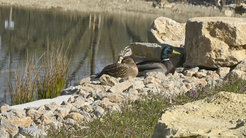
Twice they visited us, twice we unintentionally scared them away with our enthusiasm (and our cameras): A pair of ducks has discovered the pond in our biotope! The pond still lacks food and vegetation to keep them on the Fassberg for longer. We hope that in the next few years it will be transformed into a habitat for ducks – and other water loving animals of course–, so that they do not only drop by for a flying visit!

March 28, 2022
All! These! Nests!
... are the result of cleaning our nesting boxes in the last weeks. 41, that is the yield of one year after setting up almost 100 boxes. From our observations, we even know that some bird couples bred twice in their nests. Most of the nests were most likely built by great tits, blue tits, and a few nuthatches.

By the way – for these two reasons you should clean your nest boxes either in late summer or toward the end of winter:
1) Birds don’t dispose of old, abandoned nests. Instead, the next inhabitants simply build their new nest on top of the old one. As a result, the next brood is always closer to the entrance hole, making the hunt easier for predators.
2) In addition to dirt, there are always parasites and pathogens in the nest boxes, which can endanger the brood in the coming year.
For 2022, we expect a greater run on our nesting boxes. That is because last year we were late in hanging some of the boxes. Now, however, the birds had plenty of time to familiarize themselves with the housing market. We are particularly curious to see whether our tree creeper boxes will be accepted. They have only been hanging since late summer.
March 8, 2022
Pond construction in fast forward
Building the centerpiece of our biotope was a major undertaking. From March to October 2021, the diligent construction workers were plowing, digging, dredging, and planting. We filmed all the hard work and don't want to deprive you of the 2-minute video of our pond’s creation. Next to the construction site were our alpacas: Aren't they cute, how they munch their way over the meadow in fast motion?
BioDiversum in 2 minutes
If you want to see more details, you can find them in the long version of the video. Go on a discovery tour and see what it reveals!
- When can you see our alpacas and what weather conditions do they prefer?
- At what time is the water let into the pond?
- When is the opening ceremony taking place?
You can find the answers to these questions here:
January 19, 2022
All-round view at the bird feeder

We recently set up a 360° camera at our year-round bird feeder. We wanted to figure out which guests we were actually hosting. And lo and behold, we actually had a VIP for a visit: A Grey-faced woodpecker (Picus canus) eagerly helped itself to the buffet. We are particularly pleased about this, because the species is considered endangered in Germany. Grey-faced woodpeckers are easily confused with green woodpeckers, which are much more common here.
In the video, our guest of honor bumps into a visitor we hadn't planned on. Take a look:
















































